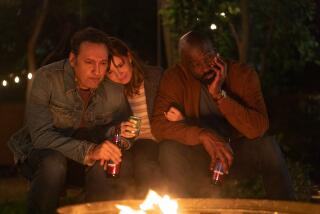In ‘The Shades,’ a family is haunted by their daughter’s death
- Share via
Early in Evgenia Citkowitz’s thrillingly hushed and haunted novel, half-doting husband Michael recalls his third date with wife-to-be Catherine: “On a lucky hunch, he had bought tickets to a concert performance of Monteverdi’s ‘L’Orfeo’ …. The opera, written in Italian, retold the mythic story of Orpheus’s journey to the underworld to bring back his wife, Eurydice, after her death. When Orfeo tries to cross the Styx, the river that separates the land of the living from the dead, Caronte, ferrymen of shades, the souls of the dead, refuses to take him, as Orfeo is still alive.”
Famously, Orfeo, a master poet, singer and lyrist, convincingly serenades Caronte, followed by Pluto, lord of the underworld, begging that love beat death, that his wife go home with him across the river. Moved, Pluto concedes — but with a rule. Orpheus may not look back until they’ve landed. Orpheus inevitably, humanly fails, losing his wife forever. “L’Orfeo” was “astonishing,” according to Michael, and the opera reduced Catherine to tears. He “offered his hand, which she took, interlacing her fingers between his.” An auspicious performance, the show bodes well for the couple.
Or does it?
The scene is part of a long reminiscence on behalf of Michael about their courtship and marriage, which ultimately leads to a painful, blunt and too recent memory: “Then Rachel was dead.” The prior year, their teenage daughter was killed in a car accident; her death has since fractured the family, leaving Catherine and Michael abiding in separate homes. She remains in their English country house while Michael stays largely in London and their son, Rowan, attends boarding school, physically and emotionally removed from his parents.
Catherine is nearly overwhelmed by grief, but not quite. She copes admirably as she obsesses over her daughter’s texts, emails, cellphone photos and the final call she missed the night of Rachel’s death.
Alternately preoccupied by the details and possible details of her daughter’s last days and the widely circling members of her family, she endures. A successful gallerist, she also worries about work, the artists she represents and the artists and the work she has lost.
The novel is suffused with loss. To name a few: the possible suicide of a young woman; the death of John Bramley, an elder artist, with whom Catherine had an intensely physical, though not sexual, relationship; and the death of Catherine’s mother (suicide? accident?), whom she never did mourn because to “to stop and mourn the opaque woman,” she thinks, “would have been to comprehend and absorb something of her pain. The best she could do was launch back into her studies and finish her dissertation, and hope that whatever had happened, her mother hadn’t suffered at the end.”
This is Catherine’s strategy, after all, and she applies the same approach to the loss of Rachel, welcoming “reconstituted wartime advice on a coffee mug … keep calm and freak out later.”
Michael, on the other hand, “saw that Catherine wasn’t as strong as he would like to believe. Although optimism was important, she was still fragile; he wasn’t sure how she’d be able to cope on her own.”
Aside from the overly critical assumption, it should also be said this comes at the tail end of Michael’s vacillating back and forth between the shores of fidelity and adultery. Which is to say, to imagine cheating with one of Catherine’s oldest friends, Paige (who knows if Paige would reciprocate): “images of Paige’s ripe limbs and aubergine hair kept coming back to him and were probably all the more delicious for being forbidden, he had surrendered to lustful thoughts in the early hours, hoping that they didn’t constitute lechery or betrayal.”
Michael seems a weak man with a weakness for soft axioms: “positivity wasn’t a mood but a precept of character”; “we must be good to each other, here and now”; “All we can ever do is hope for the best.”
The two make a contradictory and fascinating couple, married but emotionally divorced, nearly opposite in their reactions to their daughter’s death, physically removed from each other, even as their motivations and fantasies remain entangled.
And yet, for all its quiet, gripping work, this book is not without suspenseful turns of plot. Enter Keira, a young woman (Rachel’s age?) who one day mysteriously shows up at the country house, claiming to have lived there as a child. Keira draws genuine sympathy from Catherine, despite the young woman showing increasingly distressing signs of being someone other than who she claims. Trouble follows, and it’s unstoppably real.
While reading, I was often reminded of a knotty poem by the poet Kay Ryan, “The Niagara River.” In it, she frames our fleeting lives on the Niagara River, how “we / do know, we do / know this is the / Niagara River, but / it is hard to remember / what that means.” Citkowitz suggests something similar, reminding us the dead are, indeed, no longer for the living, even while testing and re-imagining the original myth. There is the idea that the dead never do wholly cross, staying on in memory, shaping our projections, paranoias, desires and dreams. But most visionary is the subtle intimation that possibly all of us are shades, to some extent, that we travel with the dead, sharing one river, on the very same water, and not just after we fall. Brilliantly constructed, “The Shades” is ghostly and alive, cerebral and sensuous, an absolutely riveting read.
Cheshire is the author of the novel “High as the Horses’ Bridles” and teaches at Queens College, City University of New York.
::
Evgenia Citkowitz
W.W. Norton: 208 pp., $25.95
More to Read
Sign up for our Book Club newsletter
Get the latest news, events and more from the Los Angeles Times Book Club, and help us get L.A. reading and talking.
You may occasionally receive promotional content from the Los Angeles Times.






